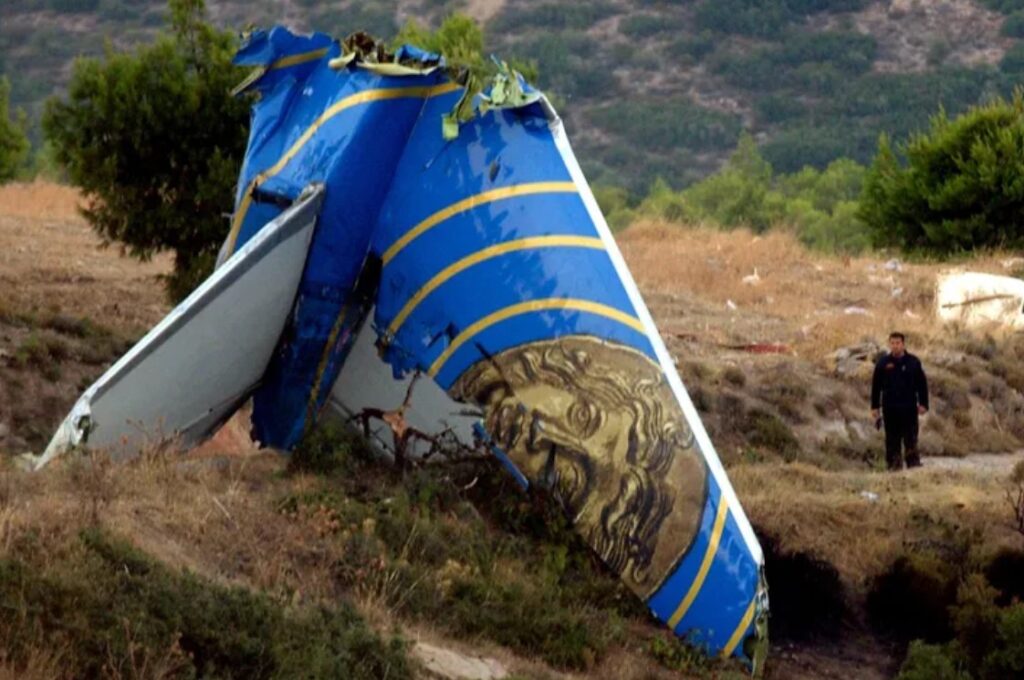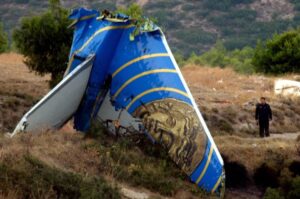Background
On August 14, 2005, Helios Airways Flight 522 carrying 115 passengers and 6 crews crashed into a mountain in Greece (AAIASB,2006). The flight was scheduled to depart from Larnaca Cyprus for Prague, Czech Republic. During the investigation, the Air Accident Investigation & Aviation Safety Board (AAIASB) found that the loss of cabin pressurization resulted in the depletion of oxygen which incapacitated the crew (AAIASB, 2006). The aircraft continued to fly on autopilot until it eventually ran out of fuel and crashed. All 121 passengers and crew perished during the accident. The accident that happened on this day was a reminder of how important the aircraft pressurisation system is and how human factors can lead to a catastrophic disaster.
Timeline

Maintenance
Prior to the flight, an inspection was done due to an issue on the right aft service door that was reported during its previous flight. An engineer proceeded to carry out a pressurization leak check. To perform this task, the pressurisation system has to be set to ‘manual’. Upon completion of the test, the pressurisation system was not reset to ‘auto’
The aircraft was signed off and sent into service for the next flight HCY522 which was scheduled to leave Larnaca International Airport for Prague, the Czech Republic with a stopover at Athens. Helios flight 522 departed Larnaca International Airport at 06:07 h (UTC).

Warning Horn
Just 5 minutes after take-off, as the aircraft continue ascending, the cabin altitude warning horn sounded at an altitude of 12 040ft. However, the crew misunderstood the alarm and identified the alarm as a takeoff configuration warning. As a result, the crew contacted the company operations centre at 06:14 h to report “take-off configuration warning on” and “cooling equipment normal and alternate off line”.
Communication with Company Operations Centre
There was an exchange between an engineer and flight crew to try and rectify the issue. In one of the exchanges, the engineer asked the flight crew to confirm that the pressurization panel is set to AUTO. However, the captain, already experiencing the onset of hypoxia’s initial symptoms disregarded the question, and instead asked in reply, “Where are my equipment cooling circuit breakers?”. As the exchange continues, the passenger oxygen mask was automatically deployed as intended at 06:14 h at an altitude of 18 000ft. Communication between the operations centre and flight crew ended at 06:20 h as the aircraft passes 28 900 ft. This was the last communication with the flight crew.
No response
At 07:12 h, the Athinai Acc Controller contacted Helios flight 522 to issue a descent clearance. There was no response from the aircraft. Attempts to establish communication on the emergency frequency and other aircrafts were unsuccessful. At 08:23 h two F16 fighter aircraft of the Hellenic Air Force intercepted Helios 522 to investigate. At 08:32 h, the F-16 pilot reported that the Captain’s seat was vacant and the First Officer slumped over the controls. There are no signs of terrorism and cabin oxygen is deployed.
Final Hope

At approximately 08:49 h, during the tenth holding pattern, the F-16 pilot observed an individual who was identified to be Andreas Prodromou, in the cockpit trying to regain control of the aircraft with Haris Charalambous, his girlfriend, assisting him. Andreas banked the plane away from Athens towards a rural area. According to the flight data recorder the left engine flamed out at 8:49 h. At 08:54 h the following distress was recorded by the cockpit voice recorder, “MAYDAY, MAYDAY, MAYDAY, Helios Airways Flight 522 Athens … (unintelligible word)” and a few seconds later, another “MAYDAY, MAYDAY”. Ten minutes after the loss of power from the left engine, the right engine also flamed out.
The aircraft continued to descend rapidly and crashed in the hilly terrain near Grammatiko village, approximately 33 km northwest of the Athens International Airport at 09:03 h.
Cause of Accident
Maintenance Engineer

During the investigation, it was found that human error was the root cause of the accident. During a maintenance check, the engineers set the plane’s pressurisation system to manual mode to check a leak that was reported during its previous flight. Unfortunately, the engineers failed to return the selector position to ‘auto’.
Flight Crew
Investigators determined that there were several opportunities for the flight crew to correct the mode selector of the plane’s pressurisation system. It was overlooked by all the flight crew on 3 major occasions: during the pre-flight checks, after-start check and after take-off check. The flight crew failed to follow the standard operating procedure.
Master caution was activated. The reason for its activation may have been either the inadequate cooling of the equipment or the deployment of the oxygen masks in the cabin. The flight crew was supposed to check for both possibilities. However, the flight crew identified the master caution to only be inadequate cooling of equipment.
With the pressurization system still set to “manual,” and the aft outflow valve partially open, the cabin altitude warning horn sounded as it passed through an altitude of 12,040 feet and the pressure inside the cabin gradually decrease. According to training and flight manuals, the flight crew should have stopped climbing as soon as they hear this warning go off. The flight crew also misidentified the alarm as a take-off configuration warning.
Contributing factors
Manufacturer
In Boeing’s aircraft maintenance manual under pressurisation check, it states to “put the airplane back to its initial condition” which is deemed to be vague and did not specifically mention returning the pressurisation selector back to AUTO after pressurisation check.
The Cabin altitude warning and take-off configuration warning are also identical which does not align with good human factors principle. There were numerous reported incidents involving the confusion between the 2 warnings on the Boeing 737 (AAISB, 2006).
Measures Implemented by Boeing and FAA after the incident
Flight crew training and awareness
In October 2005, Boeing issued a revision to their Boeing 737 Flight Crew Training Manuals (FCTM) and included a new section. This section focuses on the air systems and cabin altitude warning to remind flight crews on how to understand and determine the differences between the take-off configuration and cabin altitude warning. They also updated the FCTM and place more emphasis on the importance of checking the bleed and pack system configuration after take-off.
Revision/clarification of Aircraft Maintenance Manual
On 12 January 2006, Boeing released another revision to their Aircraft Maintenance Manual (AMM) for all 737 variants. This time, it added 2 new steps. It states that the cabin pressure mode selector on the overhead panel should be positioned to ‘AUTO’ after carrying out a cabin pressure leakage test. In addition, Boeing also added the following step. It states that any crew oxygen mask regulator that has been removed during maintenance would need to be reinstalled and tested before releasing to service.
Reconsideration of the design of the preflight checklist, controls and indicators
On January 10, 2005, Boeing released a revision to their Flight Crew Operations Manuals (FCOM) and Quick Reference Handbooks (QRH). They implemented changes to flight crew procedures with regards to the Boeing 737 Cabin Altitude Warning system. It includes changes to existing Normal Checklist (NC), replacement the old Non-Normal Checklist (NNC) with a new and updated NNC and some changes in terminologies.
Airworthiness Direction: revision to Aircraft Flight Manual
As for the FAA, they issued an Airworthiness Directive (AD) involving all Boeing 737 variants on 22 June 2006 to address issues with the aircraft. Their mandatory instructions include revisions to the Airplane Flight Manual (AFM) within 60 days. The revision included improvement to procedures involving the pre-flight setup of the cabin pressurisation system as well as interpretation and response to cabin altitude and take-off configuration warning horn.
References
AIR ACCIDENT INVESTIGATION & AVIATION SAFETY BOARD. (2006). ACCIDENT REPORT HELIOS AIRWAYS FLIGHT HCY522 BOEING 737-31S AT GRAMMATIKO, HELLAS ON 14 AUGUST 2005. https://reports.aviation-safety.net/2005/20050814-0_B733_5B-DBY.pdf
SKYbrary. (2012). Aircraft Pressurisation Systems. Skybrary.Aero. https://www.skybrary.aero/index.php/Aircraft_Pressurisation_Systems
SKYbrary. (2014). The Human Factors “Dirty Dozen” – SKYbrary Aviation Safety. Skybrary.Aero. https://www.skybrary.aero/index.php/The_Human_Factors_%22Dirty_Dozen%22#Complacency






